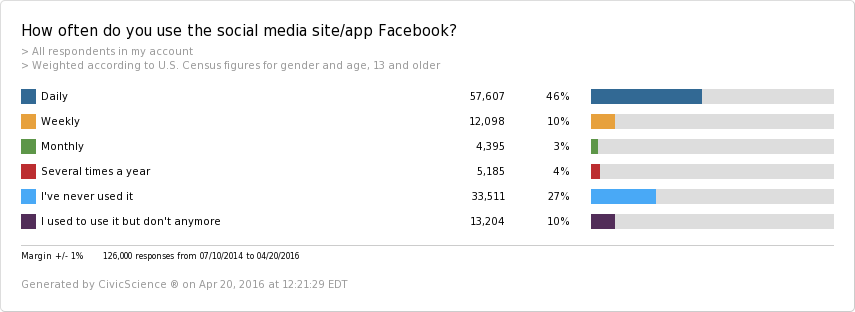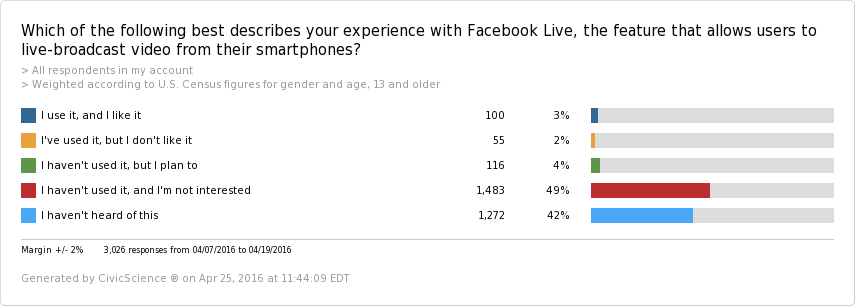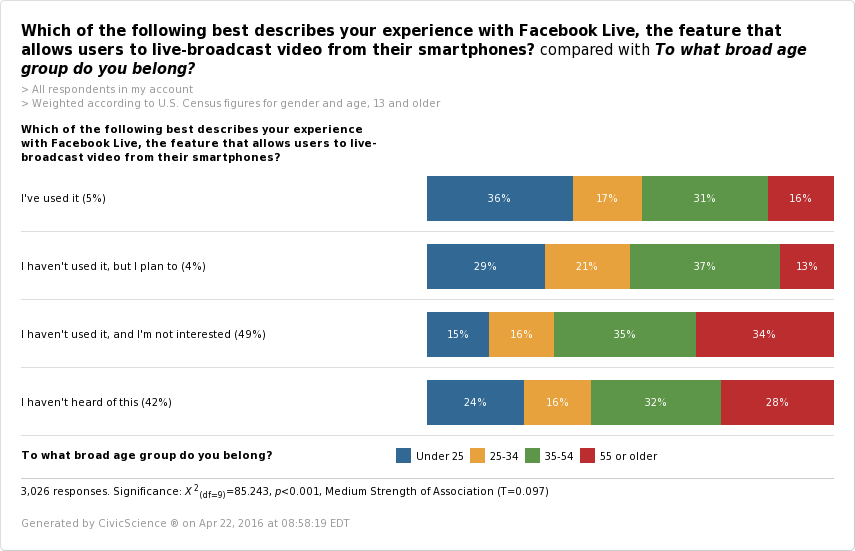I was an early user of Facebook. I remember getting my University of Kentucky email address and my best friend immediately demanding over the phone that I get on Facebook and register. That was 2005 when you had to have an “edu” address to use the social network. Just a few years later anybody could sign up for Facebook with any email address. Then in 2013, Facebook admitted to a significant loss in youth appeal.
At CivicScience we have a continuously running question about Facebook usage. I looked at 126,000 responses weighed against the US census collected over the last 21 months:

An overwhelming amount of people still use Facebook daily or weekly. However, we all know what is most challenging for the company – staying ahead of competitors, like Snapchat, Twitter, and even Vine that appeal to the shortened attention spans of today’s youth. (I’d list Instagram, but they don’t really count as competition since the acquisition).
I joined the Twitter and Snapchat bandwagons way, way later, and I still haven’t hopped onto Vine. But with the new release of Facebook Live, I think we were all expecting to see a slight surge in Facebook usage – particularly among people who like apps that are picture based, easy to access, and allow you to share “moments.” In other words, younger generations.
Cisco released a report forecasting visual consumption as the next big thing in online networking. The ability to stream live is an endeavor no app has been able to conquer comprehensively. Close to live? Sure, you can post something and maybe a few people will see it close to “now.” Streaming live, receiving live comments, and having a virtual live conversation? Now that’s impressive! Just look at the success Univision had airing videos with Facebook Live.
Soon after Facebook’s F8 annual conference, we polled about 3, 000 people to see who’s excited and who plans to use Facebook Live:

Although many people haven’t heard of it, it’s important to see who has used Facebook Live and who plans to use it. It looks like there is a real divide between whether users like the new feature or aren’t fans of it. Some tweaks may need to be made in order to keep people excited and using the Facebook Live feature.
However, there is a bit of a silver lining for Facebook: they may be able to win back some of the younger generations with this new technology. So far, a younger crowd has shown interest in the Live feature, which is great news for the social media site.

Over half (53%) of those who have used (and have a favorable or unfavorable opinion) Facebook Live are 34 and under, and 50% of those who plan to use the feature are 34 and under. It’s clear the new feature is attracting younger individuals.
Earlier, we saw there was a divide between people who used the feature and liked it and those who used it and didn’t like it. The social media platform may not have made a huge splash with Live yet, but they may be able to keep people interested and excited about the feature if they listen to feedback and make some changes. This will be especially important since they are hot on the heels of Periscope and other live streaming competitors.
One thing that may help Facebook keep younger individuals interested in the Live feature is to consider collaborating with shows, networks, and personalities. Why not use Univision’s success to propel forward with other live broadcasts like pre-game shows at national sporting events, live interviews with politicians, or new releases from admired artists?
Facebook Live has the potential to birth the next PewDiePie or Jerome Jarre, and rake in those younger users again. That’s what MTV is attempting in a partnership with Snapchat. Why not Facebook?








